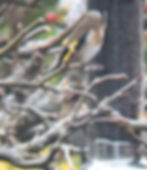For this weeks update I have decided to do something a bit different by highlighting what we, and indeed you might see in the remaining weeks of March. Things to look out for include, Brimstone Butterfly, Quaker Moths, Dark-edged Bee-fly, and Chiffchaff. There are many more species I could mention, here is a small snapshot of what you might see. Before that let me update you on the sightings from the past week.

By far the most exciting addition was the appearance of two Lesser Redpolls and my highlight of the year so far! They're by no means a super rare bird, but certainly not your average garden visitors. In my experience as a bird watcher, they're a bird you don't often catch up with, but will turn up from time to time. Generally unless you live near woodlands where they breed in more northern parts of the Brittish Isles, you're most likely to see one in winter. We have a folder with our lists of bird records in the garden which go back to 2003 and according to that we haven't seen one in or around the garden since 2009! In the photo the Redpoll is below the Goldfinch bottom left. The Lesser Redpoll is also a type of finch and about the the same size if a little smaller than a Blue Tit. Despite being a Red Listed species ironically they're much more common then their cousins the Common or Mealy Redpoll, which are pretty much exclusively a winter bird. The other additions have been, White-tailed Bumblebee, Red-tailed Bumblebee, Garden Snail, Dark-lipped Banded Snail, and Black Fly taking us to 92 species.
In the early weeks of spring and end of winter, insects start to emerge with the change in temperatures and other cues. Arguably one of the most dazzling is the Brimstone Butterfly with its sulphur yellow colour, which looks stunning when the sun catches it! Other early butterflies include Peacock, Small Tortoiseshell and Red Admiral. The White-tailed Bumblebee I saw emerged with some brief sunny weather and was a huge queen probably looking for a good place to make a nest. Most if not all the bumblebees you will see will be queens at this time of year because they're just starting to build a colony. A creature you could mistake for a bee is the Dark-edged Bee-fly. You will see them with their long proboscis lapping up nectar much like a bee. I often see them on flowers like Lesser Celandine in my garden. There is however a darker side to these charming insects as they are parasites of ground nesting solitary bees. They achieve this by flicking their eggs into the bee’s borrows where they hatch and eat the bee’s larvae. Moving on to something less gruesome, there are also many species of Quaker Moths on the wing, so called because of their modest and understated markings, but still beautiful in my mind. Their less flashy markings help to keep them camouflaged from predators, so it's with good reason. Hopefully some will turn up in the moth-trap soon.

Recently I mentioned the frogspawn and they have already changed shape in the eggs starting to look more like tadpoles. While cleaning the pond of leaves and other dead plant matter my mum also showed me two Water Hog Louse she found, which we have already seen but they're always fun to have a close look at. They're an aquatic relitive of the Woodlouse and therefore maybe surprisingly a type of crustacean. Having a pond in your garden is probably one of the best things you can do for your local wildlife and will attract so many exciting creatures to your garden! If you are worried about space even the most modest of ponds can attract wildlife. Even a pot with water would work but do make sure to provide a way for creatures like frogs to get out from the water easily. Choosing aquatic plants to oxygenate the water is also vital for a healthy pond.
Lastly, moving back to the avian world, the Chiffchaff should be starting to sing now, especially if you live near woodland. They are one of our earliest visitors to appear, having migrated from Africa, although we do have small numbers that are now resident. However, many of our resident birds are already nest building, such as Blue Tits, so keep an eye out if you have a nest-box in your garden. Grey Heron will now be feeding young as they start nesting as early as January, so can often be seen flying over at this time of year looking for food for their young. We have heronry nearby up at Gatton so they're a very familiar sight for us.
That concludes my update for this week, so until next time keep spotting! Do leave a comment if you've seen something interesting I would love to hear from you!
